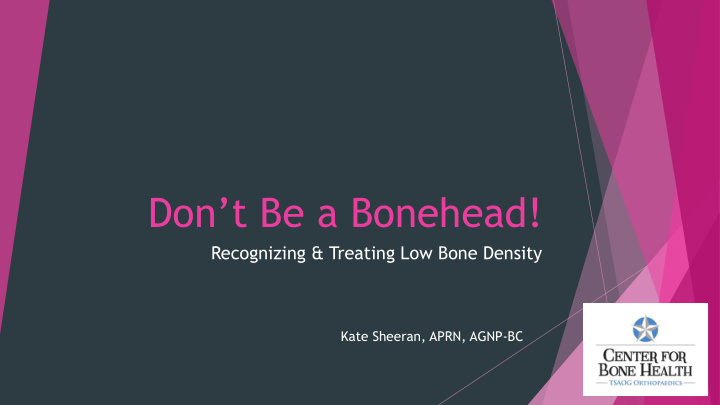



Don’t Be a Bonehead! Recognizing & Treating Low Bone Density Kate Sheeran, APRN, AGNP-BC
Disclosures u No disclosures for the purposes of this presentation
Objectives u Scope of the problem u Coordination of care models u Post-fracture care and secondary fracture prevention u Diagnostic and treatment guidelines
Scope of the Problem
What is a fragility fracture? u A fall from standing height or less that results in a fracture u Most common places to fracture are vertebral body, femoral neck, wrist and proximal humerus u The body should be able to sustain a fall like this and not fracture unless there is an underlying issue making the bones fragile
Incidence of osteoporotic fracture u 54 million adults over age 50 are at risk for osteoporotic/ fragility fracture u This is half of all people in this age bracket! J Bone Miner Res 2007;22:465–475. Published online on December 4, 2006; doi: 10.1359/JBMR.061113
Hospitalization Comparison Number of Hospitalizations during 2001 to 2011 5 4.5 4 3.5 Millions 3 4.9 2.5 2 3 2.9 1.5 1 0.7 0.5 0 Osteoporotic Stroke MI Breast Cancer Fracture Singer, A., et al. Mayo Clin Proc. 2015 Jan;90(1):53-62. doi: 10.1016/j.mayocp.2014.09.011
u Fracture related u Fracture related 6- complications month mortality include: risk is 36% u Decreased functional status & mobility u Chronic pain u Pressure injuries u Infections u Depression
By 2025: >3 million fractures $25.3 billion J Bone Miner Res 2007;22:465–475. Published online on December 4, 2006; doi: 10.1359/JBMR.061113
We just get a failing grade!
Coordination of Care How we can do better
American Orthopedic Association. What Is Own the Bone? https://www.ownthebone.org/OTB/About/What_Is_Own_the_Bone.aspx Accessed September 5, 2019
Breaking the cycle of fractures Bone Health / Fracture Primary Care Liaison Provider Busy, Busy Service Bone Health Evaluation Increased BMD, Decreased Fracture Education, Risk! Treatment
Fracture Liaison Service u Initial visit: u Referral as appropriate to dietician, physical or u Bone density testing occupational therapy, u Labs endocrinology or rheumatology u Medications u Initiation of appropriate treatment u Medical/dental history u Ongoing assessment of grief u Family history response and emotional u Lifestyle factors response to changes in health status u Fall risk assessment u Education on treatment options, appropriate nutrition and supplementation Bonanni, S., Sorensen, A. A., Dubin, J., & Drees, B. (2017). The Role of the Fracture Liaison Service in Osteoporosis Care. Missouri medicine , 114 (4), 295–298.
Diagnosing & Screening for Osteoporosis
Diagnosis of Osteoporosis u AACE Clinical Practice Guidelines u T score of -2.5 or below at lumbar spine, femoral neck or distal radius u Low-trauma spine or hip fracture ( regardless of BMD ) u T score of -1.0 to -2.5 (low bone mass or osteopenia) with a fragility fracture of proximal humerus, pelvis or possibly distal forearm u Low bone mass or osteopenia and high FRAX score American Association of Clinical Endocrinologists. Clinical Practice Guidelines for the Diagnosis and Treatment of Postmenopausal Osteoporosis. https://www.aace.com/disease-state-resources/bone-and-parathyroid/clinical-practice-guidelines/clinical-practice Accessed September 5, 2019
USPSTF Screening Guidelines u Women over 65 u Know the risk factors u Parental hip fracture u Postmenopausal and u Smoking under 65, with risk u Excess alcohol intake greater than or equal u Sex hormone deficiency to that of a 65 year u Cerebrovascular accident old without risk u Diabetes factors u History of falls u No screening u Long term corticosteroid recommended for men https://www.uspreventiveservicestaskforce.org/Page/Document/RecommendationStatementFinal/osteoporosis-screening1
u Renal impairment, cirrhosis, impaired absorption, multiple myeloma Osteoporosis u Medications contributing to low bone mass Workup u Glucocorticoids u PPIs Rule out any secondary causes u Aromatase inhibitors u Androgen deprivation therapy u Depo-Provera Labs: CBC, CMP , PTH, u SSRIs 25-OH vitamin D, TSH u Antiepileptic drugs u Heparin and warfarin Panday, K., Gona, A., & Humphrey, M. B. (2014). Medication-induced osteoporosis: screening and treatment strategies. Therapeutic advances in musculoskeletal disease , 6 (5), 185–202. doi:10.1177/1759720X14546350
Osteoporosis Treatment & Management
Bone Health Medications Bisphosphonates : stops bone resorption RANK Ligand Inhibitor: slows bone by inhibiting osteoclast activity; 3-5 resorption by inhibiting osteoclast years average treatment duration formation and survival; can be given 10+ years Oral forms Prolia (denosumab) every six months u Fosamax (alendronate) weekly dosing u injection Actonel (risendronate) weekly dosing u Boniva (ibandronate) monthly dosing u Anabolic agents: stimulate bone formation; 12-24 month treatment IV forms duration Reclast (zoledronic acid) yearly u Forteo (teriparatide) daily self- dosing u injectable Boniva (ibandronate) every 3 month u Tymlos (abaloparatide) daily self- u dosing injectable Evenity (romosozumab) monthly u injectable
Thank You!
Recommend
More recommend